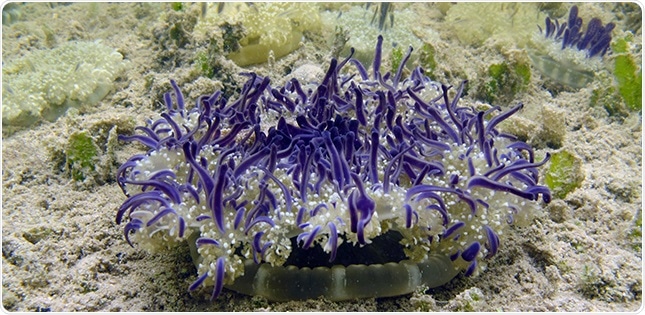Many individuals would like to prevent sloughed-off skin and bodily fluids. However, for marine biologists like Cheryl Lewis Ames, Associate Professor of Applied Marine Biology in the Graduate School of Agricultural Science at Tohoku University (Japan), such life remnants have become a magical guide to detecting the unseen.

Cassiopea is an upside-down jellyfish that rests on the bottom of the seafloor. Image Credit: Andre Morandini.
Every organism that lives in the ocean will naturally leave behind traces of its DNA—environmental DNA (eDNA)—which can be detected in ocean water samples.
Just recently has molecular sequencing technology progressed enough to perform eDNA analysis in the field to distinguish organisms that could be dangerous, endangered, or invasive and may otherwise go undetected.
Ames selected sampling sites in the Florida Keys (USA) where species of upside-jellyfish Cassiopea live to put their recently created Fieldable eDNA sequencing kit, known as FeDS, to the test.
Metabarcoding is a multistep method that uses eDNA to identify different organisms. Since the mixed DNA prototype must first be amplified using polymerase chain reaction (PCR), field metabarcoding experiments have only lately become feasible thanks to battery-powered thermocyclers and other portable instruments.
To determine the identity of a species from tiny bits of DNA filtered from seawater, a Next-Generation Sequencer (NGS) is used, which usually takes up the whole desktop counter in a laboratory and needs an electrical outlet.
The portable technology used in this research, Nanopore MinION, is unusual in that when fragments of DNA migrate through the device’s microscopic pore, variations in electrical current decide the unique code of each DNA strand.
Ames and her colleagues were researching a Nanopore device the size of a smartphone, operated by a laptop computer, instead of the usual massive sequencing machines required to complete such a process. A drop of the prepared eDNA mixture applied to the portable sequencer displays the genetic code of all the DNA going through it in real time on the computer.
The DNA sequences are then compared to a massive database of sequences to establish the species described by the eDNA collected that day.
Upgraded “offline” versions of the necessary software, as well as pre-downloading of the reference database to the desktop, ensuring that the whole metabarcoding process could be carried out outside of the confines of a laboratory, without the need for an internet connection.
Ames and his colleagues discovered 53 species of jellyfish, including Cassiopea, the upside-down jellyfish, two venomous species of box jellyfish, several species of hydroid forms, and two species of stalked jellyfish that had previously gone unnoticed in the Florida Keys, meaning that the technique could uncover species that would otherwise go unnoticed.
My hope is that one day this system is used for sting mitigation, almost like a weather forecast app that also reports 'jellyfish stings risk' at certain beaches.”
Cheryl Lewis Ames, Associate Professor, Applied Marine Biology, Graduate School of Agricultural Science, Tohoku University
Ames has spent most of her time doing experiments in places where jelly stings are frequent, and alerts about the presence of venomous jellies could save countless swimmers’ lives. Aside from realistic applications in fisheries and conservation, the fact that a study of ocean water will expose the species in its vicinity is simply amazing.
Cassiopea upside-down jellyfish filmed on the bottom of the seafloor of the mangrove waters
Video Credit: Tohoku University
Source:
Journal reference:
Ames, C. L., et al. (2021) Fieldable Environmental DNA Sequencing to Assess Jellyfish Biodiversity in Nearshore Waters of the Florida Keys, United States. Frontiers in Marine Science. doi.org/10.3389/fmars.2021.640527.